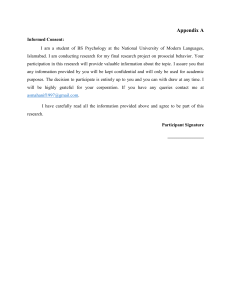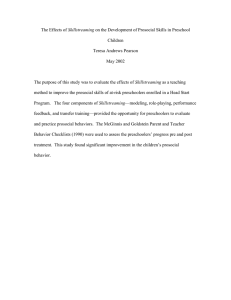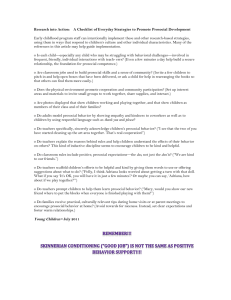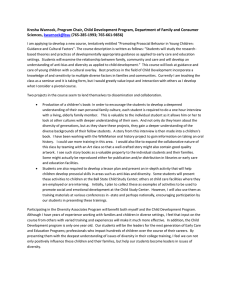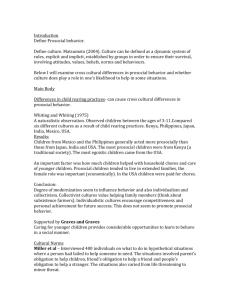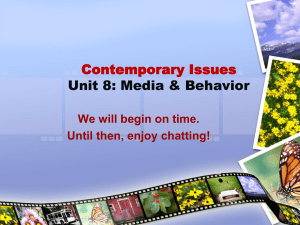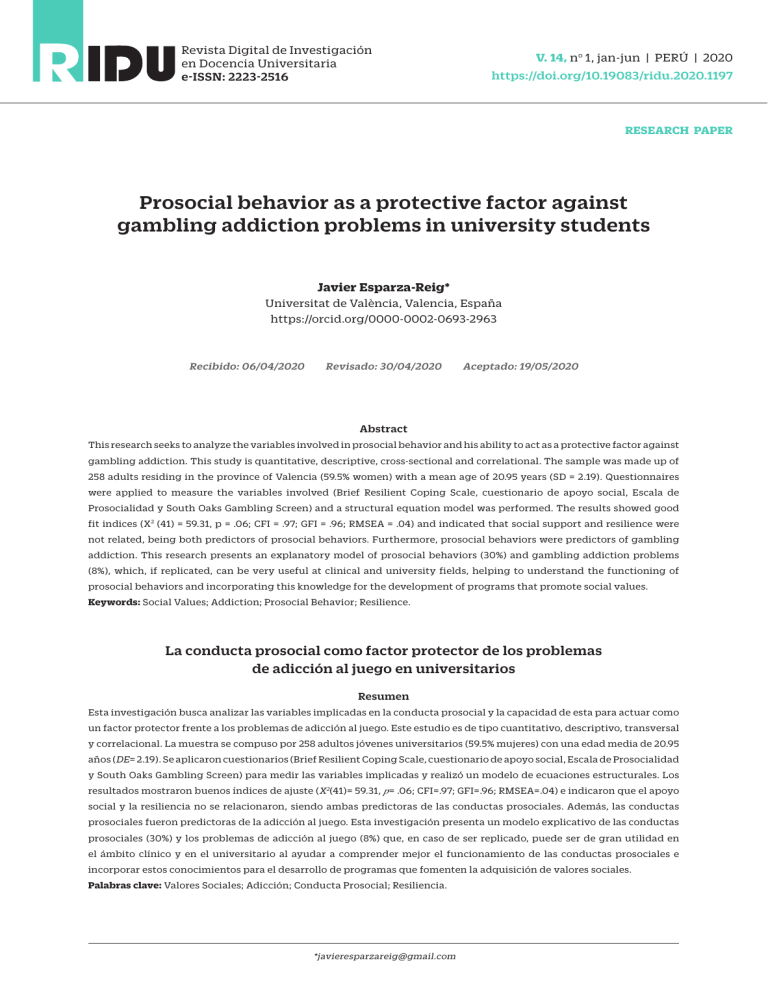
Revista Digital de Investigación en Docencia Universitaria e-ISSN: 2223-2516 V. 14, no 1, jan-jun | PERÚ | 2020 https://doi.org/10.19083/ridu.2020.1197 RESEARCH PAPER Prosocial behavior as a protective factor against gambling addiction problems in university students Javier Esparza-Reig* Universitat de València, Valencia, España https://orcid.org/0000-0002-0693-2963 Recibido: 06/04/2020 Revisado: 30/04/2020 Aceptado: 19/05/2020 Abstract This research seeks to analyze the variables involved in prosocial behavior and his ability to act as a protective factor against gambling addiction. This study is quantitative, descriptive, cross-sectional and correlational. The sample was made up of 258 adults residing in the province of Valencia (59.5% women) with a mean age of 20.95 years (SD = 2.19). Questionnaires were applied to measure the variables involved (Brief Resilient Coping Scale, cuestionario de apoyo social, Escala de Prosocialidad y South Oaks Gambling Screen) and a structural equation model was performed. The results showed good fit indices (X2 (41) = 59.31, p = .06; CFI = .97; GFI = .96; RMSEA = .04) and indicated that social support and resilience were not related, being both predictors of prosocial behaviors. Furthermore, prosocial behaviors were predictors of gambling addiction. This research presents an explanatory model of prosocial behaviors (30%) and gambling addiction problems (8%), which, if replicated, can be very useful at clinical and university fields, helping to understand the functioning of prosocial behaviors and incorporating this knowledge for the development of programs that promote social values. Keywords: Social Values; Addiction; Prosocial Behavior; Resilience. La conducta prosocial como factor protector de los problemas de adicción al juego en universitarios Resumen Esta investigación busca analizar las variables implicadas en la conducta prosocial y la capacidad de esta para actuar como un factor protector frente a los problemas de adicción al juego. Este estudio es de tipo cuantitativo, descriptivo, transversal y correlacional. La muestra se compuso por 258 adultos jóvenes universitarios (59.5% mujeres) con una edad media de 20.95 años (DE= 2.19). Se aplicaron cuestionarios (Brief Resilient Coping Scale, cuestionario de apoyo social, Escala de Prosocialidad y South Oaks Gambling Screen) para medir las variables implicadas y realizó un modelo de ecuaciones estructurales. Los resultados mostraron buenos índices de ajuste (X2(41)= 59.31, p= .06; CFI=.97; GFI=.96; RMSEA=.04) e indicaron que el apoyo social y la resiliencia no se relacionaron, siendo ambas predictoras de las conductas prosociales. Además, las conductas prosociales fueron predictoras de la adicción al juego. Esta investigación presenta un modelo explicativo de las conductas prosociales (30%) y los problemas de adicción al juego (8%) que, en caso de ser replicado, puede ser de gran utilidad en el ámbito clínico y en el universitario al ayudar a comprender mejor el funcionamiento de las conductas prosociales e incorporar estos conocimientos para el desarrollo de programas que fomenten la adquisición de valores sociales. Palabras clave: Valores Sociales; Adicción; Conducta Prosocial; Resiliencia. *javieresparzareig@gmail.com Prosocial behavior as a protective factor against gambling addiction problems in university students A conduta pró-social como o fator protetor dos problemas de dependência de jogos entre universitários Resumo Esta pesquisa procura analisar as variáveis implicadas na conduta pró-social e sua capacidade para agir como um fator protetor diante dos problemas decorrentes da dependência de jogos. Este estudo é de tipo quantitativo, descritivo, transversal e corelacional. A amostra esteve composta por 258 adultos jovens universitários (59,5% mulheres) com idade média de 20,95 anos (DE= 2.19). Aplicaram-se questionários (Brief Resilient Coping Scale, questionário de apoio social, Escala de Pró-Sociabilidade e South Oaks Gambling Screen) para medir as variáveis implicadas e realizou-se um modelo de equações estruturais. Os resultados mostraram índices de ajuste bons (X2(41)= 59.31, p= .06; CFI=.97; GFI=.96; RMSEA=.04) e mostraram que o apoio social e a resiliência não se relacionaram, sendo ambas elementos preditores das condutas pró-sociais. Além disso, as condutas pró-sociais predisseram dependência do jogo. Esta pesquisa apresenta um modelo explicativo das condutas pró-sociais (30%) e os problemas de dependência do jogo (8%) que, em caso de ser replicado, pode ser de grande utilidade no âmbito clínico e no universitário visto que ajuda a uma melhor compreensão do funcionamento das condutas pró-sociais e à incorporação de estes conhecimentos para o desenvolvimento de programas promotores da aquisição de valores sociais. Palavras-chave: Valores Sociais; Dependência: Conduta Pró-social; Resiliência. How to cite this article: Esparza-Reig, J. (2020). La conducta prosocial como factor protector de los problemas de adicción al juego en universitarios. Revista Digital de Investigación en Docencia Universitaria. 14(1), e1197. https://doi.org/10.19083/ ridu.2020.1197 P rosocial behaviors are those that seek to help another person or the rest of society; they are beneficial to them and avoid antisocial behaviors and aggressive attitudes (Martí-Vilar, Corell-García, & Merino-Soto, 2019; Rodriguez, Martí-Vilar, Esparza Reig, & Mesurado, 2019). These behaviors are considered a basic aspect in any society (Moñivas, 1996). Social values are directly related to their representations in the form of behaviors (Cornelissen, Dewitte, & Warlop, 2011). Cooperative social values and skills are manifested in prosocial behaviors towards others (Rodriguez et al., 2019), while more individualistic values are related to less prosocial behaviors (Innamorati et al., 2018). It is important to promote cooperative social values and pro-social behaviors in everyone, yet it is especially relevant to do so in university students (Palomino & Almenara, 2019), an aspect that is closely related to university social responsibility (Vallaeys, 2018). Currently, the role of universities is not limited to training professionals in certain areas, but they are also responsible for contributing to https://doi.org/10.19083/ridu.2020.1197 the education of people by encouraging them to acquire social values (Gaete, 2015a). Prosocial behaviors are a fundamental pillar to instill these values (Arango, Clavijo, Puerta, & Sánchez, 2014; Martí-Vilar, Calderón-Mirallés, & Escrig-Espuig, 2018), and it has been shown that university education influences the development of both prosocial behaviors and social values (MartíNoguera, Martí-Vilar, & Almerich, 2014). Thus, after completing their training, the professionals will join the world of labor in different areas—such as health—and should be able to incorporate these values and behaviors in the development of their career (Seoane, Tompkins, De Conciliis, & Boysen, 2016). This elements shall be implemented not only in the clinical field where patients are treated directly; the importance of promoting cooperative values and prosocial behaviors in workers has been demonstrated (Adamska-Chudzinska, 2015) in a field that differs greatly, such as business. Prosocial behaviors are located at the opposite end of antisocial ones. These types of antisocial behaviors correlate inversely with the social 2 V. 14, no 1, jan-jun | PERÚ | 2020 Esparza-Reig, J. support received by individuals (Innamorati et al., 2018). The social support received acts positively as a predictor of prosocial behaviors (Simpson, Harrell, Melamed, Heiserman, & Negraia, 2018), and negatively of antisocial behaviors (Stanger, Backhouse, Jennings, & McKenna, 2018). Lever and Estrada (2018) found that social support, along with the support from friends, social skills, and positive peer relationships predicted 61% of the variance in prosocial behaviors. This relationship between social support and prosocial behavior is maintained in very different conditions, such as a football match (Mallia, Lucidi, Zelli, Chirico, & Hagger, 2019) or among the inhabitants of a town after having overcome war situations (Ramos-Vidal, Villamil, & Uribe, 2019). To a lesser extent, the relationship between resilience and prosocial behavior has also been studied (Vargas, Villoría, & López, 2018). Resilience is the capacity of people to adapt to and face the different adverse situations that may arise (Artuch-Garde et al., 2017), and it is directly related to the prosocial behaviors of people; these two variables are necessary for good social functioning (Arias, 2015). Different research studies found that resilience is a predictor of prosocial behaviors since childhood (Ross, 2017) throughout adolescence (Vargas et al., 2018). In a study in college-age population, Brown and Lichter (2006) found that people's resilience acted as a protective factor that favored prosocial behaviors. Martínez-Martí and Ruch (2017) found that aspects, such as self-efficacy or emotional strength in people, were closely related to resilience, but there also seems to be a positive relationship between perceived social support and resilience (Li, Yang, Liu, & Wang, 2016; Young, Craig, Clapham, Banks, & Williamson, 2019). Rodríguez-Fernández, Ramos-Díaz, Ros, and Fernández-Zabala (2015) also found this relationship between social support and resilience and proposed that an individual’s environment is a protective factor that enhances resilience. On the other hand, other research studies claim that there is no relationship between both variables and that there are certain interpersonal characteristics involved in resilience (Coppari et al., 2018). The impact of prosocial behaviors can also be seen in the clinical field. There is a research trend https://doi.org/10.19083/ridu.2020.1197 that argues that both drug users and addicts engage in fewer prosocial behaviors (Carter, Johnson, Exline, Post, & Pagano, 2012; Quednow, 2017; Quednow et al., 2018), and that heroin use is associated with fewer prosocial behaviors (Miller, 2014). Some authors (Hernández-Serrano, Espada, & Guillén-Riquelme, 2016) have found that these behaviors act as predictors of the use of drugs such as cannabis. Xue, Zimmerman, and Caldwell (2007) conclude that being involved in prosocial activities, such as volunteering, acts as a protective factor against the development of addiction problems and provides people with tools to cope with exposure to risk situations and avoid the development of these problems. According to this model, it would be of vital importance to promote prosocial behaviors as a protective factor against drug use. In the case of gambling addiction, its link to prosocial behaviors has been scarcely studied, but existing research suggests that pathological gamblers show fewer prosocial behaviors, which act as predictors of gambling problems (Paleologou et al., 2019). Due to the relevance that prosocial behaviors have in the good functioning of people and society, this research tries to deepen in the study of the prosocial behavior in young university students to better understand its functioning and its effects in the development of gambling addiction so as to contribute to the improvement of programs that are intended to enhance these behaviors or prevent gambling problems. Specifically, we analyze the predictive role of social support and resilience in prosocial behavior, as well as its implications in the specific case of the occurrence of gambling addiction problems. Additionally, the relationship between social support and resilience is also analyzed. Based on these objectives, Hypothesis 1 is that the perceived social support and the resilience of college students will be positive predictors of prosocial behaviors. Hypothesis 2 is that prosocial behaviors will be a protective factor against gambling addiction, so there would be lower gambling addiction if they showed greater prosocial behavior. Finally, Hypothesis 3 is that social support and resilience will be positively related. Figure 1 shows the theoretical model proposed, which represents the hypothesized relationships. 3 V. 14, no 1, jan-jun | PERÚ | 2020 Prosocial behavior as a protective factor against gambling addiction problems in university students SS1 SS2 SS3 1 PB2 Social Support PB4 PB9 1 Prosocial Behavior Gambling Addiction Resilience 1 R1 R2 R3 R4 Figure 1. Theoretical model proposed. SS: Indicators of social support; R: Indicators of resilience; PB: Indicators of prosocial behavior. did not participate in order to ensure a good understanding of the questionnaire. Fifty-nine point 5 percent (59.5%) of the participants were female (n=153), while the sample’s mean age was 20.95 years (SD=2.19). Ninety-six point five percent (96.5%) of the participants were Spanish and 58.2% were single, compared to 39.5% who had a partner and 2.3% who were married Method Design This is a quantitative study with a descriptive approach; additionally, it has a cross-sectional and correlational design (Vallejo, 2002). Participants A total of 258 young university students between the ages of 18 and 26 who residing in the province of Valencia (Spain) completed the questionnaires. We used a non-probabilistic and convenience sample. The sample size required to carry out the analyses was estimated following the recommendations of Kline (2011), who suggests that, in order to analyze structural equation models, 20 cases are required for each variable studied. In this case, there should be more than 220, since the model proposed contains 11 variables observed. The researchers contacted the participants in their classrooms. The eligibility requirements included being of legal age and residing in Spain; students from the European Region Action Scheme for the Mobility of University Students (Erasmus) https://doi.org/10.19083/ridu.2020.1197 Instruments To measure resilience, the Brief Resilient Coping Scale (BRCS; Sinclair & Wallston, 2004) was used in its version validated for the Spanish population (Moret-Tatay, Fernández-Muñoz, Civera-Mollá, Navarro-Pardo, & Acover-de-la-Hera, 2015). This questionnaire is made up of 4 Likert-type items with 5 alternatives; higher scores are associated with higher levels of resilience. Moret-Tatay et al. (2015) found good criterion validity with the multidimensional scale of coping styles (Brief COPE; Carver, 1997). All factors on this scale correlated significantly (p<.05) with BRCS scores; the strongest correlations were found with planning (r= .62), reformulation (r= .60), and active 4 V. 14, no 1, jan-jun | PERÚ | 2020 Esparza-Reig, J. coping (r= .57). The value of alpha for this scale in this study was 0.61, which means its reliability is acceptable. The social support questionnaire was applied (MOS; Sherbourne & Stewart, 1991) in its version validated for the Spanish population (Revilla, del Castillo, Bailon, & Medina, 2005). This scale analyzes the perceived social support and is made up of 19 Likert-type items with 5 alternatives and an additional item that evaluates the size of a person's social network. This instrument showed good convergent validity with the social support scale of the Coping Strategies Inventory (CSI; Tobin, Holroyd, Reynolds, & Wigal, 1989) (r= .21, p<.001) (Priede et al., 2016). In this study, only the total score was used and the alpha value for this scale was 0.94, so it showed very high reliability. To measure prosocial behavior, the Prosociality Scale of Caprara, Steca, Zelli, & Capanna (2005) was also used. This scale measures prosocial behavior in teenagers and adults, differentiating those who are more prosocial from those who are less prosocial, based on the Caprara and Pastorelli's (1993) prosocial behavior scale for children. In this study, we used an adapted version used in MartíVilar, Merino-Soto, & Rodriguez (2020). This scale is made up of 16 Likert-type items with 5 response alternatives ranging from 1 to 5. Rodriguez, Mesurado, Oñate, Guerra, & Menghi (2017) found good convergent validity of this instrument with the Prosocial Tendencies Measure (Carlo & Randall, 2002); the strongest correlation was found with the sensitive tendency (r= .61, p< 001), followed by the anonymous tendency (r= .31, p< 001) and the public tendency (r= .11, p< 001). The value of alpha for this scale in the research was 0.89, thus it showed high reliability. Finally, to measure gambling addiction, the South Oaks Gambling Screen (SOGS; Lesieur & Blume, 1987) was applied in its validated version for the Spanish society (Echeburúa, Báez, FernándezMontalvo, & Páez, 1994). This instrument is made up of 20 items (the majority being dichotomous) and includes 3 previous items that are not included in the total score and are used to evaluate the type of game or bet, the maximum amount bet, and intimate relationships with gambling problems. The Spanish validation score ranges from 0 to 19, with the authors considering a score https://doi.org/10.19083/ridu.2020.1197 above 4 as indicative of a gambling problem. In this original version, all items evaluate gambling addiction throughout the subject's life. This instrument showed good convergent validity with the diagnostic criteria of the DSM-III-R with a correlation of 0.92 (p<.001) (Echeburúa et al., 1994). The alpha value for this questionnaire in the research was 0.80, so it showed good reliability. Procedures This cross-sectional study is part of a wider study that seeks to explain the functioning of gambling addiction and its consequences. The Universitat de València's Experimental Research Ethics Committee approved this research (procedure number 1040164). The sample was collected between May and December of 2019 in different schools of the Universitat de València. The participants completed the questionnaire on paper and one of the researchers was present at all times in order to guarantee an appropriate environment to conduct the research and resolve any possible doubts. The questionnaire had a duration of around 50 to 60 minutes. Before participating in the research, all participants signed an informed consent form that stated the terms of the research and highlighted that the data collected would be completely anonymous. No incentives were offered to participants. Data Analysis Before contrasting the hypotheses, the sample distribution and the response frequencies were analyzed, and confirmatory factor analyses were carried out to adapt the structure of the instruments. Then, to test the hypotheses, a structural equation model (SEM) was tested following the theoretical proposal set out in Figure 1. This type of analysis offers the advantage of analyzing all the hypotheses simultaneously and including several dependent variables with their corresponding measurement errors, as well as the correlation between variables or errors (Manzano, 2018). We followed the recommendations proposed by Medrano & Muñoz-Navarro (2017) for this type of analysis and we also used the maximum likelihood method, eliminating outliers and missing values and previously examining multivariate normality, according to Manzano's (2018) recommendations. Finally, Mardia’s coefficient was also calculated. 5 V. 14, no 1, jan-jun | PERÚ | 2020 Prosocial behavior as a protective factor against gambling addiction problems in university students To select indicators of social support, resilience, and prosocial behavior, we followed the recommendations of Hall, Snell, & Foust (1999) on item bias. Gambling addiction, on the other hand, was considered an observed variable while the rest were latent; therefore, we used the direct score obtained in the SOGS. To evaluate model fit, all fit indices were examined, but only the values of X2/gl, the comparative fit index (CFI), the goodness-of-fit index (GFI), and the approximation mean square error (RMSEA) are presented below. X2/gl is proposed as an alternative to the use of X2 to avoid alterations due to the sample size; values below 3 are considered a good fit (Iacobucci, 2010). The rest of the fit indices were analyzed according to the cut-off points established in one of the more widespread proposals (Hu & Bentler, 1999; Marsh, Hau, & Wen, 2004). For both the IFC and the GFI, values above 0.95 were considered an optimal fit, while values above 0.90 were regarded as a good fit. For the RMSEA, values below 0.06 were considered an optimal fit and below 0.08 were an acceptable fit. All analyses performed in this research were conducted by using the statistical program SPSS 20.0 and AMOS 24. Results Table 1 shows the results obtained from the participants in the different variables used to compare the model proposed. The Mardia’s coefficient was 19.88, so, although it was not significant—being less than 70—, it was not a deviation from normality that represented a critical inconvenience for the use of the most common estimation method in this type of analysis (maximum likelihood) (Pérez, Medrano, & Sánchez Rosas, 2013), All the goodness-of-fit indices evaluated (both those presented and all those reviewed) showed that the empirical data fit well with the theoretical model proposed. The Chi-square (X2 (41)= 59.31, p= .06), as it was not significant, reflected a good fit of the model. However, this statistical element can be altered by the sample size, so the correction was made considering the degrees of freedom; this correction also showed that the model had a good fit as it was lower than 3 (X2/gl= 1.37). The rest of the goodness-of-fit indices analyzed are more robust to the influence of the sample size. Both the CFI with a value of 0.97 and the GFI with 0.96 showed an optimal model fit, just as the RMSEA with a value of 0.04. Table 1 Descriptive analysis of the model’s variables observed Variable N Median SD PB2 258 3.53 .66 PB4 258 2.97 1.00 PB9 258 3.36 .71 BRCS1 258 3.24 1.05 BRCS2 258 3.31 1.06 BRCS3 258 4.12 0.91 BRCS4 258 3.5 1.00 Gambling addiction 258 0.71 1.48 SS1 258 4.42 0.67 SS2 258 4.19 0.83 SS3 258 4.51 0.70 https://doi.org/10.19083/ridu.2020.1197 6 V. 14, no 1, jan-jun | PERÚ | 2020 Esparza-Reig, J. Figure 2 shows the model after the re specification with the standardized parameters obtained. Specifically, the values represented are those of the correlations, the standardized regression weights, and the percentage of the explained variance of the model’s dependent variables. All hypothesized regressions were statistically significant. Both social support and resilience were predictors of variance in prosocial behavior, which in turn predicted variance in gambling addiction. As for the last hypothesized relationship, social support and resilience did not show a statistically significant correlation as shown in Table 3. As shown in Figure 2, the model proposed explained 30% of the variance in prosocial behaviors and 8% of the variance in gambling problems. It was not necessary to impose restrictions on the re specification of the model since it is already correctly identified. Table 2 Regression weights for hypothesized relationships Regression weight Relationships between variables Prosocial behavior ← ← Prosocial behavior Gambling addiction ← Estimate SE CR p Standardized Social Support .32 .07 4.86 *** .41 Resilience .32 .10 3.30 *** .33 Prosocial behavior -.87 .24 -3.62 *** -.29 ***p<0,001. SE: standard error; CR: critical ratio. e1 e2 ,84 e3 ,37 SS1 ,52 SS2 SS3 ,61*** ,92*** e8 ,72*** e9 ,55 ,16 PB2 Social Support e10 PB4 ,74*** ,32 PB9 ,39*** ,57*** ,30 ,41*** ,08 Prosocial Behavior ,12 ‑,29*** Gambling Addiction ,33*** D2 Resilience D1 ,42*** ,50*** ,17 ,73*** ,25 ,51*** ,53 ,26 R1 R2 R3 R4 e7 e6 e5 e4 Figure 2. Final re-specified SEM. *** p< .001. https://doi.org/10.19083/ridu.2020.1197 7 V. 14, no 1, jan-jun | PERÚ | 2020 Prosocial behavior as a protective factor against gambling addiction problems in university students Table 3 Relationship between resilience and social support Relationships between variables Resilience ↔ Social Support Covariances Estimate SE CR p Correlation .04 .03 1.45 .15 .12 but it follows the line of other research works that found lower levels of prosocial behaviors in people with substance dependence disorders (Carter et al., 2012) and that placed prosocial behaviors as predictors of other addiction problems, such as cannabis use (Hernández-Serrano et al., 2016) or heroin use (Miller, 2014). People's prosocial behaviors would act as a protective factor against addiction problems by providing them with a series of tools that would help them deal with situations that pose a risk of developing these gambling addiction problems (Xue et al., 2007). Finally, Hypothesis 3 argued that the social support perceived by university students and their resilience capacity would be positively related, so that the greater the social support, the greater the resilience capacity and vice versa (Li et al., 2016; Rodríguez-Fernández et al., 2015; Young et al., 2019). In this case, the results obtained lead to the rejection of Hypothesis 3, since no significant relationship has been found between the two variables (Coppari et al., 2018). These results could be due to the characteristics of the sample in particular or, as suggested by Coppari et al. (2018), to the existence of certain interpersonal characteristics that are involved in this resilience. This last proposed theory is supported by other research studies that found that social support was not one of the characteristics most related to resilience, yet we could find others such as self-efficacy or emotional strength (Martínez-Martí & Ruch, 2017). The theoretical model in Figure 1 reflected all these hypothesized relationships, and the empirical results show an optimal fit. The model appears to be valid and is likely to be replicated in future research, since both the prosocial behavior and the gambling addiction were explained in a statistically significant way by the model. Encouraging social values such as prosocial behavior is important at all stages of life to contribute to the good of society and of the people Discussion The aim of this research was to study in depth the functioning and practical implications of prosocial behavior in young university students. Specifically, we aimed to analyze the implications of social support and resilience on prosocial behaviors and the effect that the latter may have on the development of gambling addiction problems. Finally, as an additional objective, the relationship between social support and resilience was also discussed. Hypothesis 1 suggested that both the social support perceived by university students and their resilience to problems would act as positive predictors of prosocial behavior, so that university students with greater social support and resilience would engage in more prosocial behaviors. The results obtained fully corroborate this hypothesis, since both social support (Lever & Estrada, 2018; Mallia et al., 2019; Ramos-Vidal et al., 2019; Simpson et al., 2018) and resilience (Ross, 2017; Vargas et al., 2018) were shown to be good predictors, explaining 30% of the variance in prosocial behaviors. The effect that resilience has on prosocial behaviors is especially interesting, since it is a relationship that lacks extensive research (Vargas et al., 2018), especially in a sample of college-age individuals (Brown & Lichter, 2006). Hypothesis 2 of this research claimed that the prosocial behaviors of university students would act as a protective factor against the development of a gambling addiction. In this case, the hypothesized relationship was negative, since the more prosocial behaviors found, the fewer chances of gambling addiction problems. The results obtained in the research are consistent with this hypothesis, as the relationship was negative and significant (Paleologou et al., 2019). This relationship has hardly been studied so far, https://doi.org/10.19083/ridu.2020.1197 8 V. 14, no 1, jan-jun | PERÚ | 2020 Esparza-Reig, J. who make it up. As other research studies suggest, it is important for young people (both university and non-university students) to develop their prosocial behaviors in order to better practice professionally and benefit society (AdamskaChudzinska, 2015; Seoane et al., 2016). In order to enhance this development, it is essential to know the factors that influence these behaviors and to address them in the same way, not focusing on prosocial behavior only. Particularly in the case of university students, in order for universities to fulfill their mission of contributing to the education of people so they develop a series of social values (Gaete, 2015a), the programs they implement must encourage the prosocial behaviors of the participants (Arango et al., 2014; Martí-Noguera et al., 2014). Currently, the main programs offered by universities to promote social values are volunteering and social relief activities, both being prosocial behaviors (Gaete, 2015b; Martí Vilar et al., 2018); however, they are not promoted very often (Martí-Vilar et al., 2018). The results obtained in this research suggest that any program that tries to promote prosocial behavior in university students should also include an assignment on the social support perceived by the students and their resilience capacity, which is a very novel point in the research of prosocial behavior. On the other hand, we also discuss the influence that prosocial behaviors exert on the development of gambling addiction problems in the university population. This relationship reflects the importance of enhancing prosocial behaviors, not only for the objectives mentioned above, but also as a protective factor against the development of gambling addiction problems in young adults. Finally, the most novel contribution of this research is the model that has been tested. The use of such powerful analytical methods as SEMs is of vital importance in order to obtain the most reliable and robust results and conclusions possible. This model, if replicated in subsequent research studies to test its effectiveness, would be useful both in the clinical and higher education settings. Specifically, in the development of programs that universities implement to try to promote social values in their participants, which focus on the development of prosocial https://doi.org/10.19083/ridu.2020.1197 behaviors to acquire these values or prevention and intervention programs in gambling addiction problems, since they provide a theoretical and empirical basis on some aspects that should be addressed in such programs. The main limitation of this research is that it analyzed a university sample without specific problems. The particular case of people with behavioral problems in the form of antisocial behavior or people with gambling addiction problems should be addressed in future research by replicating this model in samples with these characteristics. Furthermore, following the results of this research, future studies that analyze the protective factors against the development of gambling addiction problems should consider prosocial behavior as one of them. In short, in addition to analyzing some relationships of prosocial behavior that have been scarcely studied, this research provides a model that, if tested in future studies, can be very useful in both the university and health fields. References Adamska-Chudzinska, M. (2015). Link between work-related prosocial orientation and professional capability of employees: A preliminary exploratory investigation. Entrepreneurial Business and Economics Review, 3(1), 107-118. https://doi. org/10.15678/EBER.2015.030108 Arango, O.E.; Clavijo, S.J.; Puerta, I.C. & Sánchez, J.W. (2014). Formación académica, valores, empatía y comportamientos socialmente responsables en estudiantes universitarios. Revista de la educación superior, 43(169), 89-105. https://doi.org/10.1016/j. resu.2015.01.003 Arias Gallegos, W. (2015). Prosocial behavior and positive psychology. Avances En Psicología Latinoameri- cana, 23(1), 37-47. Recuperado de http://revistas. unife.edu.pe/index.php/avancesenpsicologia/article/download/169/161 Artuch-Garde, R., del Carmen Gonzalez-Torres, M., de la Fuente, J., Mariano Vera, M., Fernandez-Cabezas, M.; & Lopez-Garcia, M. (2017). Relationship between resilience and self-regulation: A study of spani- 9 V. 14, no 1, jan-jun | PERÚ | 2020 Prosocial behavior as a protective factor against gambling addiction problems in university students sh youth at risk of social exclusion. Frontiers in Capítulo 1. Responsabilidad social universitaria: re- Psychology, 8, UNSP 612. https://doi.org/10.3389/ alidad emergente en el ámbito de la educación, 13- fpsyg.2017.00612 26. https://doi.org/10.15517/aie.v15i1.17729 Brown, J.B. & Lichter, D.T. (2006). Childhood Disadvantage, Gaete, R. (2015b). El voluntariado Universitario como ámbi- Adolescent Development, and Pro-Social Behavior to de aprendizaje servicio y emprendimiento social: in Early Adulthood. Advances in Life Course Re- Un studio de caso. Última década, 23(43), 235-260. search, 11, 149-170. https://doi.org/10.1016/S1040- https://doi.org/10.4067/S0718-22362015000200009 2608(06)11006-0 Hall, R. J., Snell, A. F.; & Foust, M. S. (1999). Item Parceling Caprara, G.V. & Pastorelli, C. (1993). Early emotional insta- Strategies in SEM: Investigating the Subtle Effects bility, prosocial behaviour, and aggression: some of Unmodeled Secondary Constructs. Organiza- methodological aspects. European Journal of tional Research Metrods, 2(3), 233-256. https://doi. Personality, 7(1):19-36. http://dx.doi.org/10.1002/ org/10.1177/109442819923002 per.2410070103 Hernández-Serrano, O., Espada, J. P.; & Guillén-Riquelme, A. Caprara, G. V., Steca, P., Zelli, A.; & Capanna, C. (2005). A new (2016). Relación entre conducta prosocial, resolu- scale for measuring adults’ prosocialness. Europe- ción de problemas y consumo de drogas en adoles- an Journal of Psychological Assessment, 21(2), 77- centes. Anales De Psicología, 32(2), 609-616. https:// 89. https://doi.org/10.1027/1015-5759.21.2.77 doi.org/10.6018/analesps.32.2.204941 Carlo, G. & Randall, B. (2002). The development of a measure Hu, L. T. & Bentler, P. M. (1999). Cutoff criterio for fit indexes of prosocial behaviors for late adolescents. Journal in covariance structure analysis: Conventional cri- of Youth and Adolescents, 31, 31-44. teria versus new alternatives. Structural equation modeling: a multidisciplinary journal, 6(1), 1-55. ht- Carter, R.R., Johnson, S.M., Exline, J.J., Post, S.G. & Pagano, M.E. (2012). Adicction and “Generation Me”: Narcis- tps://doi.org/10.1080/10705519909540118 sistic and Prosocial Behaviors of Adolescents with Iacobucci, D. (2010). Structural equations modeling: Fit ín- Substance Dependency Disorder in Comparison dices, Sample size, and advanced topics. Journal of to Normative Adolescents. Alcoholism Treatment Consumer Psychology, 20(1), 90-98. https://doi.or- Quarterly, 30(2), 163-178. https://doi.org/10.1080/07 g/10.1016/j.jcps.2009.09.003 347324.2012.663286 Innamorati, M., Parolin, L., Tagini, A., Santona, A., Bosco, Carver, C.S. (1997). You want to measure coping but your A., De Carli, P., . . . Sarracino, D. (2018). Attachment, protocol’s too long: consider the brief COPE. Inter- social value orientation, sensation seeking, and bu- national Journal of Behavioral Medicine, 4(1), 92- llying in early adolescence. Frontiers in Psycholo- gy, 9, 239. https://doi.org/10.3389/fpsyg.2018.00239 100. https://doi.org/10.1207/s15327558ijbm0401_6 Coppari, N., Codas, G., López Humada, H., Martínez, Ú, Kline, R. (2011). Principles and Practice of Structural Equa- Martínez, L.; & Montanía, M. (2018). Relación entre tion Modeling (3ª ed.). New York: The Guildford apoyo social percibido y disposición resiliente en Press. adolescentes paraguayos. Psychologia, 12(2), 13-22. Lesieur, H. R. & Blume, S. B. (1987). The south oaks gambling https://doi.org/10.21500/19002386.3415 screen (SOGS) - a new instrument for the identification of pathological gamblers. American Journal of Cornelissen, G., Dewitte, S.; & Warlop, L. (2011). Are social va- Psychiatry, 144(9), 1184-1188. lue orientations expressed automatically? decision making in the dictator game. Personality and Social Lever, J. P. & Victorio Estrada, A. (2018). Predictors and co- Psychology Bulletin, 37(8), 1080-1090. https://doi. rrelates of prosocial behavior of mexican adolescents. Interdisciplinaria, 35(2), 495-509. org/10.1177/0146167211405996 Echeburúa, E., Báez, C., Fernández-Montalvo, J.; & Páez, D. Li, M., Yang, Y., Liu, L.; & Wang, L. (2016). Effects of social su- (1994). Cuestionario de juego patológico de south pport, hope and resilience on quality of life among oaks (SOGS): Validación española. Análisis y Modi- chinese bladder cancer patients: A cross-sectional ficación de Conducta, 20(74), 769-791. study. Health and Quality of Life Outcomes, 14, 73. Gaete, R. (2015a). La responsabilidad social universitaria https://doi.org/10.1186/s12955-016-0481-z desde la perspectiva de las partes interesadas: un Mallia, L., Lucidi, F., Zelli, A., Chirico, A.; & Hagger, M. S. studio de caso. Primera parte. Fundamentos con- (2019). Predicting moral attitudes and antisocial ceptuales de la responsabilidad social universitaria behavior in young team sport athletes: A self-de- https://doi.org/10.19083/ridu.2020.1197 10 V. 14, no 1, jan-jun | PERÚ | 2020 Esparza-Reig, J. termination theory perspective. Journal of Ap- Moret-Tatay, C., Fernández-Muñoz, J. J., Civera-Mollá, C., plied Social Psychology, 49(4), 249-263. https://doi. Navarro-Pardo, E.; & Alcover-de-la-Hera, C. (2015). org/10.1111/jasp.12581 Psychometric properties and Factor structure of Manzano Patiño, A. P. P. (2018). Introducción a los modelos the BRCS in an elderly Spanish sample. Anales de de ecuaciones estructurales. Metodología de Inves- Psicología, 31(3), 1030-1034. https://doi.org/10.6018/ tigación en Salud Médica, 7(25), 67-72. analesps.31.3.188401 Marsh, H. W., Hau, K. T.; & Wen, Z. (2004). In search of golden Paleologou A., Lazaratou H., Anagnostopoulos D., Econo- rules: Comment on hypothesis-testing approaches mou M., Malliori M., Papadimitriou G.; & Papageor- to setting cutoff values for fit indexes and dangers giou C. (2019). Problem gambling and concurrent in overgeneralizing Hu and Bentler’s (1999) fin- emotional/behavioral problems among Greek ado- dings. Structural equation modeling, 11(3), 320-341. lescents. Turk Pedriatri Arsivi-Turkish Archives of https://doi.org/10.1207/s15328007sem1103_2 Pediatrics, 54(3), 166-172. Martí-Noguera, J. J.; Martí-Vilar, M., i Almerich, G. (2014). Palomino, P. & Almenara, C. A. (2019). Inteligencia Emo- Responsabilidad Social Universitaria: Influencia de cional en Estudiantes de Comunicación: Estudio valores y empatía en la autoatribución de Compor- Comparativo bajo el Modelo de Educación por tamientos socialmente responsables. Revista Lati- Competencias. Revista Digital de Investigación noamericana de Psicología, 46(3), 160-168. https:// en Docencia Universitaria, 13(1), 1-16. https://doi. doi.org/10.1016/S0120-0534(14)70019-6 org/10.19083/ridu.2019.840 Martí-Vilar, M., Calderón-Mirallés, L. & Escrig-Espuig, J.M. Pérez, E., Medrano, L.A. & Sánchez Rosas, J. (2013). El Path (2018). Responsabilitat Social Universitària i Con- Analysis: conceptos básicos y ejemplo de aplica- ducta Prosocial: una Revisió de la Literatura. Anu- ción. Revista Argentina de Ciencias del Comporta- ari de Psicología de la Societat Valenciana de Psi- miento, 5(1), 52-66 cología, 19(2), 157-181. Priede, A., Andreu-Vaillo, Y., Martínez-López, P., Ruiz-To- Martí-Vilar, M., Corell-Garcia, L.; & Merino-Soto, C. (2019). rres, M., Hoyuela, F. & González-Blanch, C. (2016). Systematic review of prosocial behavior measu- Validación de la Escala MOS-SSS de Apoyo Social en res. Revista De Psicologia PUCP, 37(1), 349-377. ht- una Muestra de Pacientes Oncológicos Recién Diag- tps://doi.org/10.18800/psico.201901.012 nosticados. Psicooncología, 13(1), 1-47. https://doi. Martí-Vilar, M., Merino-Soto, C. & Rodriguez, L.M. (2020). org/10.5209/rev_PSIC.2016.v13.n1.52192 Measurement invariance of the prosocial behavior Quednow, B. B. (2017). Social cognition and interaction in scale in three hispanic countries (Argentina, Spain, stimulant use disorders. Current Opinion in Behav- and Peru). Frontiers in Psychology. 11, 29. https:// ioral Sciences, 13, 55-62. https://doi.org/10.1016/j. doi.org/10.3389/fpsyg.2020.00029 cobeha.2016.10.001 Martínez-Martí, M. L.; & Ruch, W. (2017). Character strengths Quednow, B. B., Hulka, L. M., Preller, K. H., Baumgartner, predict resilience over and above positive affect, M. R., Eisenegger, C. & Vonmoos, M. (2017). Stable self-efficacy, optimism, social support, self-esteem, self-serving personality traits in recreational and and life satisfaction. Journal of Positive Psycholo- dependent cocaine users. Plos One, 12(3), e0172853. gy, 12(2), 110-119. https://doi.org/10.1080/17439760. https://doi.org/10.1371/journal.pone.0172853 2016.1163403 Ramos-Vidal, I., Villamil, I. & Uribe, A. (2019). Underlying di- Medrano, L. A. & Muñoz-Navarro, R. (2017). Aproximación mensions of social cohesion in a rural community conceptual y práctica a los Modelos de Ecuaciones affected by wartime violence in Colombia. Inter- Estructurales. Revista Digital de Investigación en national Journal of Environmental Research and Docencia Universitaria, 11(1), 219-239. https://doi. Public Health, 16(2), 195. https://doi.org/10.3390/ org/10.19083/ridu.11.486 ijerph16020195 Miller, T. (2014). Social Determinants of Youth Heroin Use Revilla, L., del Castillo, L. J., Bailon, E. & Medina, M. I. (2005). (Electronic Thesis or Dissertation). University of Validacion del cuestionario MOS de apoyo social en Cincinnati, Cincinnati. Atencion Primaria. Medicina de Familia (And), 6(1), Moñivas, A. (1996). La conducta pro-social. Cuandernos de 10-18. trabajo social, 9, 125-142. Recuperado de https://di- Rodriguez, L.M., Mesurado, B., Oñate, M.E., Guerra, P. & Men- alnet.unirioja.es/servlet/articulo?codigo=119468 https://doi.org/10.19083/ridu.2020.1197 ghi, M.S. (2017). Adaptación de la Escala de Proso- 11 V. 14, no 1, jan-jun | PERÚ | 2020 Prosocial behavior as a protective factor against gambling addiction problems in university students cialidad de Caprara en Adolescentes Argentinos. Stanger, N., Backhouse, S. H., Jennings, A.; & McKenna, Revista Evaluar, 17(2), 177-187. J. (2018). Linking motivational climate with mo- Rodriguez, L.M., Martí-Vilar, M., Esparza Reig, J. & Mesura- ral behavior in youth sport: The role of social do, B. (2019). Empathy as a predictor of prosocial support, perspective taking, and moral disen- behavior and the perceived seriousness of delin- gagement. Sport Exercise and Performance Psy- quent acts: A cross-cultural comparison of argenti- chology, na and spain. Ethics & Behavior. Publicación antici- spy0000122 pada online. https://doi.org/10.1080/10508422.2019 7(4), 392-407. https://doi.org/10.1037/ Tobin, D.L., Holroyd, K.A., Reynolds, R.V. & Wigal, J.K. (1989). .1705159 The hierarchical factor structure of the coping strategies inventory. Cognitive Therapy and Research, Rodríguez-Fernández, A., Ramos-Díaz, E., Ros, I. & Fernán- 13, 643-361. dez-Zabala, A. (2015). Relations of resilience to self-concept and perceived social support in a sam- Vallaeys, F. (2018). Las diez falacias de la Responsabilidad ple of adolescents. Acción Psicológica, 12(2), 1-14. Social Universitaria. Revista de Investigación en https://doi.org/10.5944/ap.12.2.14903 Docencia Universitaria, 12 (1), 34-58. http://dx.doi. Ross, J. (2017). You and me: Investigating the role of self-eva- org/10.19083/ridu.12.716 luative emotion in preschool prosociality. Journal Vallejo, M. (2002). Research design: A brief methodological of Experimental Child Psychology, 155, 67-83. ht- review. Archivos de cardiología de México, 72(1), 8-12. tps://doi.org/10.1016/j.jecp.2016.11.001 Vargas Peña, K., Villoría Torres, Y. A.; & López Guerra, V. M. Seoane, L., Tompkins, L. M., De Conciliis, A. & Boysen,Philip (2018). Factores protectores de la conducta proso- G.,,II. (2016). Virtues education in medical school: cial en adolescentes: Un análisis de ruta. Revista The foundation for professional formation. Ochs- Electrónica De Psicología Iztacala, 21(2), 563-589. ner Journal, 16(1), 50-55. Recuperado de https://www.medigraphic.com/cgi- Sherbourne, C. D., & Stewart, A. L. (1991). The MOS social su- bin/new/resumen.cgi?IDARTICULO=81579 pport survey. Social Science and Medicine, 32(6), 705- Xue, Y., Zimmerman, M.A., Caldwell, C.H. (2007). Nei- 714. https://doi.org/10.1016/0277-9536(91)90150-B ghborhood Residence and Cigarette Smoking Simpson, B., Harrell, A., Melamed, D., Heiserman, N.; & Ne- Among Urban Youths: The Protective Role of graia, D. V. (2018). The roots of reciprocity: Grati- Prosocial Activities. American Journal of Public tude and reputation in generalized exchange sys- Health, 97(10), 1865-1872. https://doi.org/10.2105/ tems. American Sociological Review, 83(1), 88-110. AJPH.2005.081307 https://doi.org/10.1177/0003122417747290 Young, C., Craig, J. C., Clapham, K., Banks, S.; & Williamson, A. Sinclair, V. G. & Wallston, K. A. (2004). The development (2019). The prevalence and protective factors for re- and psychometric evaluation of the Brief Resilient silience in adolescent aboriginal australians living Coping Scale. Assessment, 11(1), 94-101- https://doi. in urban areas: A cross-sectional study. Australian org/10.1177/1073191103258144 and New Zealand Journal of Public Health, 43(1), 8-14. https://doi.org/10.1111/1753-6405.12853 RIDU / Revista Digital de Investigación en Docencia Universitaria / e-ISSN: 2223-2516 © The authors. This article is being published by the Educational Quality Department’s Research Area Revista Digital de Investigación en Docencia Universitaria, Universidad Peruana de Ciencias Aplicadas (UPC). This is an open-access article, distributed under the terms of the Attribution-ShareAlike 4.0 International Creative Commons License (http://creativecommons. org/licenses/by-sa/4.0/), which allows the non-commercial use, distribution and reproduction in any media, provided the original work is properly cited. https://doi.org/10.19083/ridu.2020.1197 12 V. 14, no 1, jan-jun | PERÚ | 2020
